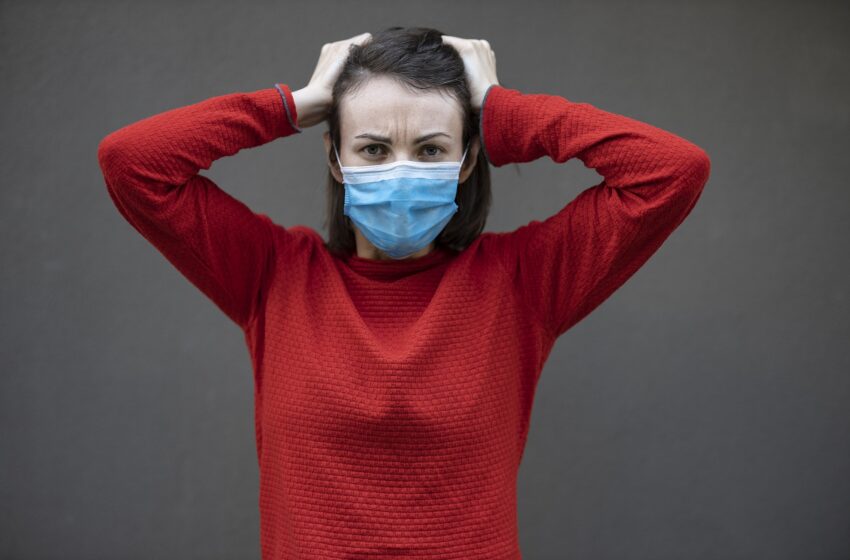Unfolding the Folds of Breast – World Breastfeeding Week 2021

Mental illness of Individuals during Covid-19 Outbreak & Scope of Homoeopathy
Reference CAMPHORA OFFICINALIS
India is the second most populated country in the world, and currently, more than 1.3 billion people were in lockdown since 25th March. The government took this step in fear for an outbreak in the country since it is densely populated; the result could have been catastrophic1, if not taken timely and followed strictly. However, these measures are the largest of their kind in the world. They risk heaping further hardship on the quarter of the population who live below the poverty line and the 1.8 million who are homeless.2 As a whole, India is facing lockdown for the first time in its history. To date, there is no profound evidence showing how quarantine affects anxiety among the general population during isolation in India. However, there are a few reports from Kashmir which are facing Complete lockdown since August 2019, describing an increase in patients experiencing anxiety, stress sufferings, loneliness, frustration and abnormalities in behavior.3
In the area of Isolation People stressed due to longer quarantine duration as well as infection fears, frustration, boredom, inadequate supplies, inadequate information, financial loss, stigma as well as anxiety, which may turn into depression and high perceived stress. The study indicate that 25.3 % of the participants are facing anxiety, which is very high from prevalence (3.6%) estimated in National Mental Health Survey (2015-16) in the general population.5 The mental health status of isolated people due to Middle East Respiratory Syndrome (MERS) in South Korea found the prevalence of anxiety using GAD-7 to be 7.6 %, which is one-third of the prevalence in this study. In another study of psychological distress determined by the Kessler 10 Psychological Distress Scale among a population affected by highly infectious Equine influenza in Australia, the
anxiety was reported to be 34%. Uncertainty captures the ideas of fear for one’s health or the health of loved ones, disruption to daily life, and the unknown aspect of disease.6
Besides, this pandemic is impacting a population already facing challenges in their lives like unemployment, family issues and various other changes like lifestyle, which is included as a significant reason for anxiety.4 It determines a lower rate of anxiety among males. Other studies in India7,8 as well as in Palestine9, Germany10, UK11 and US12 also report males to have a lower degree of anxiety. Globally, the prevalence of anxiety disorders was almost double in females (5.2 %) as compared to males (2.8 %) estimated using 272.2 million people in 2010.13 One explanation of why women tend to be more prone to stress is because they ruminate about life stressors, which can increase their anxiety, while men engage more in active, problem-focused coping.14 In India, it is common for females to serve the family, and especially during the lockdown, females are managing household chores and office work at home. They have to keep up with the demands of all the family members constantly, such as food and cleaning, as well as home-schooling children, who are also not able to get their regular education due to the lockdown. Thus, rendering females physically and mentally exhausted, which may contribute to higher anxiety levels. Other reasons may be that women are more likely to experience physical and mental abuse than men14, and abuses of any kind are found to be linked to the development of anxiety disorders.14 Occupations such as Business/Self-employed are also found to be predictors of anxiety in the present study. Currently, industries like tourism, textile, and agriculture along with the employment generated through this are at greater risk.15
In total, about 100 million and more Indians’ jobs are at risk during and even beyond the Covid-19 lockdown. Retailers of non-food items have closed their outlets, and food retailers are also expecting loss.16 One of the risk factors of anxiety among isolated people in South Korea due to MERS was financial loss. Fear of financial loss was higher among businessmen or self-employed individuals.13 In the present study, Muslims were found to be at a higher risk of anxiety compared with Hindus. One reason for higher anxiety among Muslims was repeated hate crimes in recent years.17 Furthermore, the health ministry repeatedly blamed an Islamic seminary group gathering for spreading the coronavirus, and governing party officials spoke of “human bombs” and “corona jihad” resulting in a spree of anti-Muslim attacks across the country.18
There is evidence from study indicated a strong positive relationship between socio-cultural adversities and psychological distress.19 Another reason could be, about half of the Indian Muslims are self-employed20, so they are at more risk of financial loss compared to their counterparts. In earlier studies, marital status was not shown to influence levels of Anxiety21, but our study showed that unmarried people have more anxiety than ever-married people. Similar findings were also registered in Western Australia, New South Wales22 and US.23 Economic down-turn affects adult unemployment as well as education, and this could be a contributing factor as to why unmarried people experience a higher level of anxiety. The total participants were made up of 42 % students, and most of them were unmarried. Students are likely to be anxious and worried about their education especially their exams, and their career since the economy has taken a downturn. The thought of being in poor health likely makes them more prone to anxiety.24 This lends credence to prior studies that suggest close associations between health status and anxiety.25 Lower levels of self-reported health status may give rise to sleep disturbances, fatigue, pain that may trigger worry and anxiety.
The inverse association between anxiety and health status also raises the possibility that anxiety may cause poorer health status. We postulate that the presence of anxiety may be associated with lower compliance with medical treatments, thus undermining health.25 Also, anxiety among our sample may be because patients are facing problems in accessing health services amid lockdown.26 Our study reported higher anxiety issues in those who reported sleep deprivation. Similar findings were also reported in the German Population using GAD-7.10 The sleep pattern of people altered due to self-isolation and routine changes. A change in the amount of time spent outside could most likely influence the routine at home, for instance, time of awakening and sleeping and time of a meal. Many people may feel more fatigue related to the mental workload associated with covid-19, and this fatigue can also be caused by psychological states, such as stress and anxiety.27 The pandemic has made people confused and uncertain and given some a sense of trepidation. All these feelings can lead to poor sleep quality, which in turn can make people more tired and anxious.25
In the light of above facts one can able to determine the psychological impact of Covid-19 lockdown on the Indian population. This observation was made with the sight to collect mental health-related data among the Indian population during lockdown amid disease outbreak, and it may have been done for the first time in the current scenario. It indicate that the Indian population under lockdown is affected by heightened psychological distress and thus higher prevalence of anxiety. It is also observed that certain groups were more vulnerable to anxiety; specifically, female, Muslims, self-employed, never married, reported poor health and reported poor sleep.
KEYNOTE MENTAL SYMPTOMS IS COMMONLY FOUND IN MOST OF THE COVID PATIENTS.26
- Delirium, repeats the same sentence
- Rage, blame others
- Anxiety, chill during
- Attention amelioration
- Death, sensation of
- Fear, left alone, to be
- Restlessness, tossing about in
- Shrieking, screaming, shouting
- Unconsciousness, chill during
- Hide, desire to
- Escape, attempts to
- Forsaken feeling, isolation, sensation of.
- Sudden weakness, fainting spells growing worse.27
PROVER OF CAMPHORA SAMUEL HAHNEMANN’S NOTES
Dr. Samuel Hahnemann is the first prover of Camphor Officinalis. He observed in proving of CAMPHOR that…
180. Stuffed Coryza. Deep and slow respiration. Opressed, anxious, painting respiration. [ORTEL,1.c.] Heavy, slow, difficult breathing (aft. 11/4 h.) [Hrr.] Almost complete suspension of the respiration.26
185. The breathing almost entirely ceases. [CULLEN,1.c.] On the sternum superiorly, pressure as from a weight. [Fz.] pressure on the sternum when standing (aft.27h.).[Fz.] Soft pressure internally on the chest under the sternum, with difficult inspiration, and a chilling sensation, which rose out of the chest into the mouth (aft. 29 h.). [Fz.] Mucus in the wind pipe, which makes the voice not clear, and is not removed by hacking cough and hawking. 26
245. Tearing cramp pain on the dorsum of the foot up along the outside of the calf to the thigh (aft.13h.).[Fz.] Discomfort in the whole body (aft.3h.). [Hrr.]. 26
260. Extreme weakness. [DE MEZA, 1.c.]. 26
295. over sensitive to cold air. 26
310. Body is quite cold all over.26
Considering these symptoms (few or all) I found that the CAMPHORA is well indicated in case of COVID-19 infections & I got the result quite satisfactory & encouraging. My experience is very much favoring CAMPHORA as a good homoeopathic medicine in preventing Covid-19 & curative as well. I tried 200 CH, 1000 CH potencies in frequent doses & found 1000 CH(1M) is more effective potency in prevention & cure of COVID-19.
References
1. BBC, “Coronavirus: India defiant as millions struggle under lockdown.” [Online].Available: https://www.bbc.com/news/world-asia-india-52077395. [Accessed: 30- Mar-2020].
2. E. Schmall and S. Saaliq, “Jobless after virus lockdown, India’s poor struggle to eat,” The Washington Post, Mar-.
3. S. Amin, “Curfew in Kashmir taking a toll on mental health of locals,” Eastmojo, 31-Oct-2019.
4. N. Davis, “‘Urgent studies needed’ into mental health impact of coronavirus,” The Guardian, 15-Apr-2020.
5. R. S. Murthy, “National Mental Health Survey of India 2015 – 2016,” Indian J.
Psychiatry, vol. 59, no. 1, pp. 21–26, 2017.
6. M. A. Cava, K. E. Fay, H. J. Beanlands, E. A. McCay, and R. Wignall, “The
experience of quarantine for individuals affected by SARS in Toronto,” Public Health Nurs., vol. 22, no. 5, pp. 398–406, 2005.
7. S. Mina, M. Jabeen, S. Singh, and R. Verma, “Gender differences in depression and anxiety among atopic dermatitis patients,” Indian J. Dermatol., vol. 60, no. 2, p. 211,Mar. 2015.
8. A. Thour, R. Nagra, A. Gosal, T. Sehrawat, S. Das, and Y. Gupta, “Anxiety among patients with diabetes mellitus evaluated using generalized anxiety disorder 7-item scale,” J. Soc. Heal. Diabetes, vol. 4, pp. 133–136, 2016.
9. H. Allabadi et al., “Depression and anxiety symptoms in cardiac patients: A crosssectional hospital-based study in a Palestinian population,” BMC Public Health, vol. 19, no. 1, pp. 1–14, 2019.
10. A. Hinz et al., “Psychometric evaluation of the Generalized Anxiety Disorder Screener GAD-7, based on a large German general population sample,” J. Affect. Disord., vol. 210, pp. 338–344, 2017.
11. O. Remes, N. Wainwright, P. Surtees, L. Lafortune, K.-T. Khaw, and C. Brayne, “Sex differences in the association between area deprivation and generalised anxiety disorder: British population study,” BMJ Open, vol. 7, no. 5, p. e013590, May 2017.
12. X. Dong, R. Chen, and M. A. Simon, “Anxiety among community-dwelling U.S.
Chinese older adults,” Journals Gerontol. – Ser. A Biol. Sci. Med. Sci., vol. 69, no. 13, pp. S61–S67, 2014.
13. A. J. Baxter et al., “The regional distribution of anxiety disorders: implications for the Global Burden of Disease Study, 2010,” Int. J. Methods Psychiatr. Res., vol. 23, no. 4, pp. 422–438, Dec. 2014.
14. O. Remes, “Women are far more anxious than men – here’s the science,” The
Conversation, 2016. [Online]. Available: https://theconversation.com/women-are-farmore- anxious-than-men-heres-the-science-60458. [Accessed: 18-Apr-2020].
15. L. Nayar, J. Sood, Y. Kansara, and S. Ahmad, “100 Million And More Indian Jobs Are At Risk After COVID-19 Lockdown. Is Your Job Safe?,” Outlook India, Apr-2020.
16. “Lockdown impact on jobs: Retailers expect around 80,000 job losses, says survey,” The Economics Times, 07-Apr-2020.
17. BBC, “India’s Muslims fear for their future under Narendra Modi,” BBC, 16-May-2019.
18. J. Gettleman, K. Schultz, and S. Raj, “In India, Coronavirus Fans Religious Hatred,”The New York Times, 12-May-2020.
19. GOI, “Social, Economic and Educational Status of the Muslim Community of India,”2006.
20. C. Nieder and T. A. Kämpe, “Does Marital Status Influence Levels of Anxiety and Depression Before Palliative Radiotherapy?,” In Vivo, vol. 32, no. 2, pp. 327–330,2018.
21. M. O’Connor, K. White, L. J. Kristjanson, K. Cousins, and L. Wilkes, “The prevalence of anxiety and depression in palliative care patients with cancer in Western Australia and New South Wales.,” Med. J. Aust., vol. 193, no. S5, pp. S44-7, Sep. 2010.
22. S. Robinson and J. Leach, “Feeling More Tired Than Usual During Lockdown?
Psychologists Explain Why,” Science alert, Apr-2020.
23. R. D. Kocalevent, A. Hinz, E. Brähler, and B. F. Klapp, “Determinants of fatigue and stress,” BMC Res. Notes, vol. 4, no. 238, pp. 1–5, 2011.
24. Sohini, “India’s COVID-19 lockdown hits HIV+ and chronic patients hard,” Al
Jazeera, 30-Mar-2020.
25. A. N. Niles and A. O’Donovan, “Comparing anxiety and depression to obesity and smoking as predictors of major medical illnesses and somatic symptoms.,” Heal. Psychol., v ol. 38, no. 2, pp. 172–181, 2019.
26. Samuel Hahnemann,”Materia Medica Pura, Vol.I, Pg. 305-318; B. Jain Publishers (P) Ltd. New Delhi.
27. S.R.Phatak,”Materia Medica of Homoeopathic medicine, Pgs. 166-169; B. Jain Publishers (P) Ltd. New Delhi.
Note: The views and opinions expressed are solely those of the author and does not necessarily reflect the views held by The Homeopath, its creators or employees. The Homeopath is not responsible for the accuracy of any of the information supplied by guest bloggers.






1 Comment
Thanks ,Informative,&as CME,